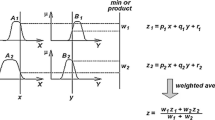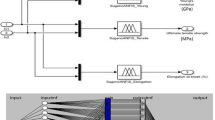Abstract
In this paper, an adaptive neuro-fuzzy inference system (ANFIS) is developed for effective prediction of yarn tenacity and unevenness based on a set of six input cotton fibre properties, i.e. fibre strength, fibre elongation, upper half mean length, uniformity index, fineness and short fibre content. The ANFIS model integrates the advantageous features of both the systems of fuzzy control and neural network. A neural network is applied with learning and computational capability in fuzzy control. On the other hand, fuzzy control provides high level of knowledge and fuzzy rules for use in the neural network. Using a past experimental dataset, the developed ANFIS model is trained and subsequently tested to envisage yarn tenacity and unevenness values. Its prediction performance is validated with respect to five statistical metrics, i.e. correlation coefficient, mean absolute percentage error, root-mean-square error, coefficient of efficiency and variance performance index, and is also contrasted against other prediction tools, like multivariate regression analysis, artificial neural network, fuzzy logic and support vector machine. Based on their acceptable values, it can be concluded that the ANFIS models can be effectively employed for prediction of diverse yarn quality characteristics while treating fibre properties as the input variables.














Similar content being viewed by others
References
S. Vassiliadis, M. Rangoussi, A. Cay, C. Provatidis, Artificial Neural Networks and Their Applications in the Engineering of Fabrics. In: Woven Fabric Engineering (ed.) P. D. Dubrovski, 111–134 (2010)
C. L. P. Hui, N. S. Fun, C. Ip, Review of Application of Artificial Neural Networks in Textiles and Clothing Industries over Last Decades. In: Artificial Neural Networks - Industrial and Control Engineering Applications, (ed.) K. Suzuki, 3–34 (2010)
R. Chattopadhyay, Artificial Neural Networks in Yarn Property Modeling. In: Soft Computing in Textile Engineering (ed.) A. Majumder, Woodhead Publisher, UK, 105–125 (2011)
A. Majumdar, P.K. Majumdar, B. Sarkar, Selecting cotton bales by spinning consistency index and micronaire using artificial neural networks. AUTEX Res. J. 4(1), 1–8 (2004)
A. Majumdar, P.K. Majumdar, B. Sarkar, Application of an adaptive neuro-fuzzy system for the prediction of cotton yarn strength from HVI fibre properties. J. Text. Inst. 96(1), 55–60 (2005)
R. Chattopadhyay, Application of neural network in yarn manufacturer. Ind. J. Fibre Text. Res. 31(1), 160–169 (2006)
M.E. Üreyen, H. Kadoğlu, The prediction of cotton ring yarn properties from AFIS fibre properties by using linear regression models. Fibers Text. East. Euro. 15(4), 63–67 (2007)
A. Majumder, A. Ghosh, Yarn strength modeling using fuzzy expert system. J. Eng. Fibers Fabr. 3(4), 61–68 (2008)
A. Majumdar, Modeling of cotton yarn hairiness using adaptive neuro-fuzzy inference system. Ind. J. Fiber Text. Res. 35, 121–127 (2010)
A. Ghosh, P. Chatterjee, Prediction of cotton yarn properties using support vector machine. Fibers Polym. 11(1), 84–88 (2010)
R. Furferi, M. Gelli, Yarn strength prediction: a practical model based on artificial neural networks. Adv. Mech. Eng. (2010). https://doi.org/10.1155/2010/640103
Z-J, Lv, Q. Xiang, J-G. Yang, Application of genetic algorithm-support vector machine for prediction of spinning quality. In: Proc. of the World Congress on Engineering, London, 1–6 (2011)
D. Nurwaha, X.H. Wang, Using intelligent control systems to predict textile yarn quality. Fibers Text. East. Euro. 20(1), 23–27 (2012)
D. Banerjee, A. Ghosh, S. Das, Yarn strength modelling using genetic fuzzy expert system. J. Inst. Eng. India Ser. E 93(2), 83–90 (2013)
K.A.A. Abakar, C. Yu, The performance of data mining techniques in prediction of yarn quality. Int. J. Innov. Manag. Technol. 4(4), 390–393 (2013)
S. Das, A. Ghosh, A. Majumdar, D. Banerjee, Yarn engineering using hybrid artificial neural network-genetic algorithm model. Fibers Polym. 14(7), 1220–1226 (2013)
A.R. Fallahpour, A.R. Moghassem, Yarn strength modelling using adaptive neuro-fuzzy inference system (ANFIS) and gene expression programming (GEP). J. Eng. Fibers Fabr. 8(4), 6–18 (2013)
İ Özkan, Y. Kuvvetli, P.D. Baykal, R. Erol, Comparison of the neural network model and linear regression model for predicting the intermingled yarn breaking strength and elongation. J. Text. Inst. 105(11), 1203–1211 (2014)
M. Dashti, V. Derhami, E. Ekhtiyari, Yarn tenacity modeling using artificial neural networks and development of a decision support system based on genetic algorithms. J. AI Data Min. 2(1), 73–78 (2014)
H. Ghanmi, A. Ghith, F. Fayala, T. Benameur, Modeling ring spun yarn tensile properties using fuzzy inference system. Int. J. Appl. Res. Text. 4(2), 12–19 (2016)
S.A. Malik, A. Farooq, T. Gereke, C. Cherif, Prediction of blended yarn evenness and tensile properties by using artificial neural network and multiple regression. AUTEX Res. J. 16(2), 43–50 (2016)
S. Chakraborty, P.P. Das, V. Kumar, A grey fuzzy logic approach for cotton fibre selection. J. Inst. Eng. India Ser. E 98(1), 1–9 (2017)
E. Hadavandi, S. Mostafayi, P. Soltani, A grey wolf optimizer based neural network coupled with response surface method for modeling the strength of siro-spun yarn in spinning mills. Appl. Soft Comput. J. 72, 1–13 (2018)
A. El-Geiheini, S. ElKateb, M.R. Abd-Elhamied, Yarn tensile properties modeling using artificial intelligence. Alexandria Eng. J. (2020). https://doi.org/10.1016/j.aej.2020.07.049
S.R. Jang, ANFIS: Adaptive-network-based fuzzy interference system. IEEE Trans. Syst. Man Cybern. 23(3), 665–685 (1993)
S.R. Jang, C.T. Sun, E. Mizutani, Neuro Fuzzy and Soft Computing (Prentice Hall, Hoboken, 1997)
Z.-C. Lin, C.-Y. Liu, Analysis and application of the adaptive neuro-fuzzy interference system in prediction of CMP machining parameters. Int. J. Comput. Appl. Technol. 17(2), 80–89 (2003)
U. Çaydaş, A. Hasçalık, S. Ekici, An adaptive neuro-fuzzy inference system (ANFIS) model for wire-EDM. Expert Syst. Appl. 36, 6135–6139 (2009)
R.B. Azhiri, R. Teimouri, M.G. Baboly, Z. Leseman, Application of Taguchi, ANFIS and grey relational analysis for studying, modeling and optimization of wire EDM process while using gaseous media. Int. J. Adv. Manuf. Technol. 71, 279–295 (2014)
Funding
There was no outside funding or grants received that assisted in this study.
Author information
Authors and Affiliations
Corresponding author
Ethics declarations
Conflict of interest
The authors declare that they have no conflict of interest.
Additional information
Publisher's Note
Springer Nature remains neutral with regard to jurisdictional claims in published maps and institutional affiliations.
Rights and permissions
About this article
Cite this article
Das, P.P., Chakraborty, S. Adaptive Neuro-fuzzy Inference System-based Modelling of Cotton Yarn Properties. J. Inst. Eng. India Ser. E 102, 257–272 (2021). https://doi.org/10.1007/s40034-021-00217-1
Received:
Accepted:
Published:
Issue Date:
DOI: https://doi.org/10.1007/s40034-021-00217-1




